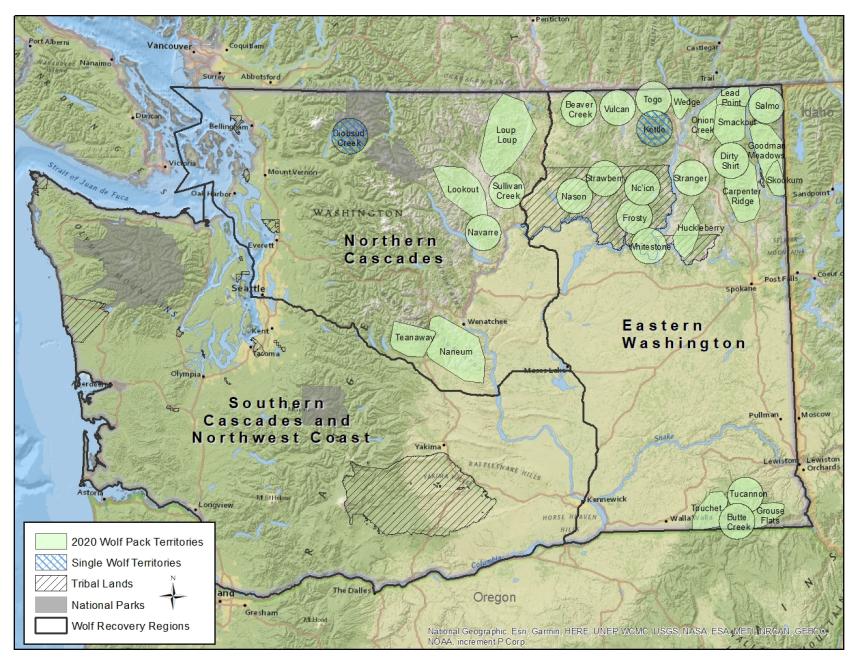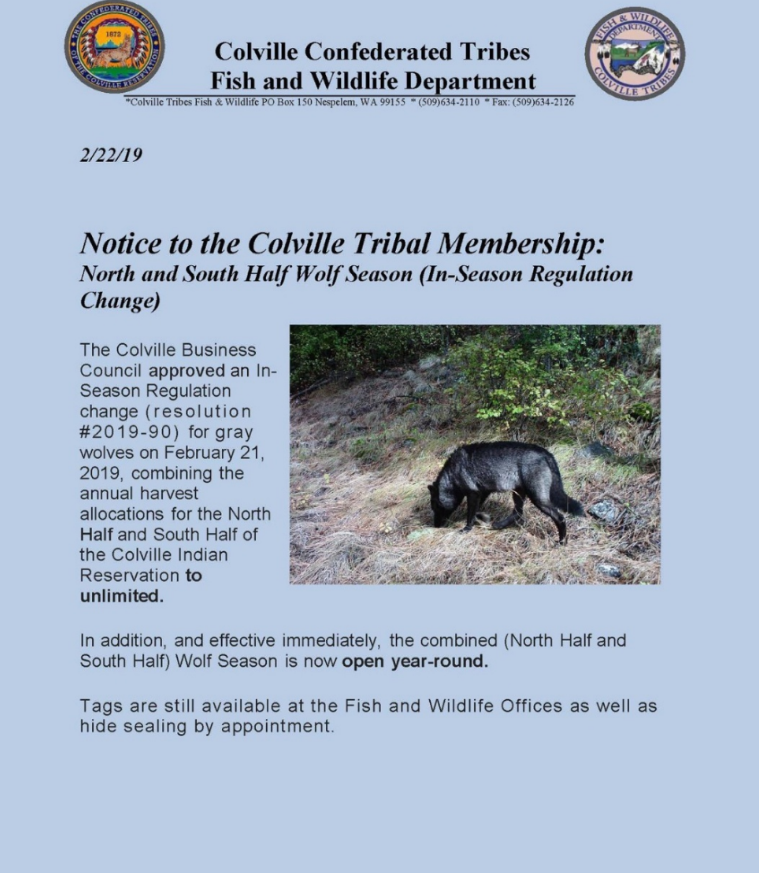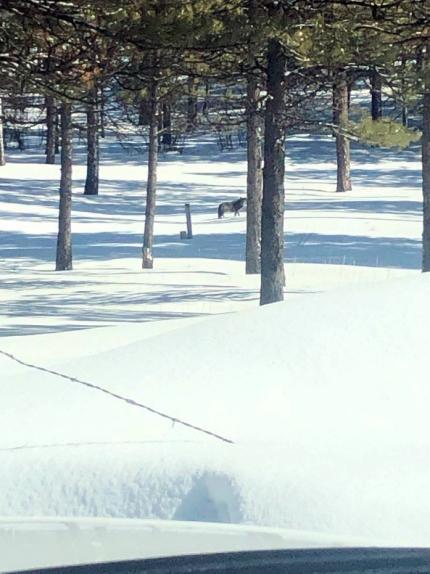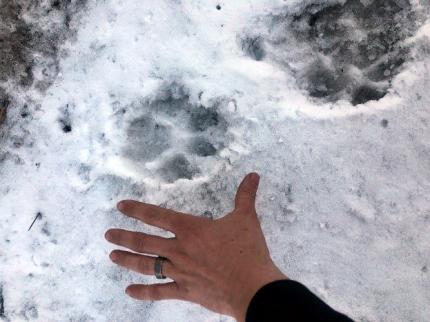Program and General Updates
Commission presentation details information provided in 2018 Wolf Report
Ben Maletzke, Statewide Wolf Specialist, and Dan Brinson, Conflict Section Manager, presented the department’s 2018 Annual Wolf Report to the Washington Fish and Wildlife Commission at a meeting, April 5, in Olympia. The report is available to the public at https://wdfw.wa.gov/publications/02062 and includes updates on wolf plan recovery progress, listing status, population monitoring, population trends, livestock-wolf interactions, and research.
U.S. Fish and Wildlife proposal on federal delisting of gray wolves
On March 15, 2019, the USFWS published a proposal to federally delist gray wolves in the lower 48 states. Under the proposal, wolves in the western two-thirds of Washington (i.e., west of the Eastern Washington recovery region in figure below) would be federally delisted and the entire state would be managed by WDFW, except for tribal reservations.

WDFW is well-prepared for this proposal as the Department has an existing wolf conservation and management plan that covers the breadth of Washington. Should the USFWS federal delist wolves as proposed the department will continue to work closely with our partners, stakeholders, and communities, just as we have over the past decade, on wolf conservation and management in Washington.
Colville Confederate Tribes wolf hunting season
On February 22, 2019, the Colville Confederate Tribes announced changes to their wolf hunting program. The Colville Tribal members have a legal right to hunt and fish on the Colville Indian Reservation and an area referred to as the former "North half" of the reservation (i.e., the area of land between the Okanogan and Columbia Rivers between the Colville Indian Reservation and the Canadian Border).

The wolf-hunting season in the North and South half is open only to tribal members, and is open year-round with unlimited take this year. However, the tribe has allowed wolf hunting for several years. During past years, they implemented quotas and shorter seasons. The annual harvest on all tribal lands has been relatively low, ranging from one to six within a calendar year.
Although wolves are a state-listed species in this part of Washington, a tribal hunt at the anticipated harvest level is not expected to represent a conservation or recovery concern to the regional or statewide wolf population.
Washington's wolf population is increasing annually. The annual rate of increase averages 28%. The local recovery objective for wolves in the eastern Washington zone is four successful breeding pairs; the number of successful breeding pairs from the 2018 annual population survey was three times the objective.
Communication and Coordination
WDFW initiated a new working group comprised of WDFW staff and external stakeholders to re-evaluate the wolf location data-sharing process administered by the department. The intent of the group is to find collaborative solutions that help livestock producers living in wolf country understand the location of wolf packs to prevent conflict with livestock where wolves and livestock overlap. The group held its first in-person meeting at the Region 1 Office in Spokane. WDFW staff provided a demonstration of how to view the data, how to change the transparency of layers, and what the data means. The committee came up with five different draft options on ways to illustrate and share the data. Committee members will be checking in with their respective stakeholder and community groups and share what they learned at the next in-person meeting.
Statewide Wolf Capture, Survey, and Management
WDFW staff conducted aerial surveys on wolves in the Teanaway, Loup Loup, and northeast Washington. They were able to capture and collar one adult male wolf in the Loup Loup pack and one yearling male in the OPT pack.

A wolf biologist and the local district biologist conducted a snow track survey northwest of Mt. Rainier in areas where the public reported wolf activity. No wolf sign was documented on this trip. Also during March, wolf biologists in cooperation with National Park Service staff conducted a wolf track survey west of Stehekin at the head of Lake Chelan. During the fall, remote camera images of wolves were captured in this area and biologists were trying to determine if wolf activity continued through the winter. No wolf sign was observed on this trip, but staff will continue to monitor these areas.
Reports of remote camera images, videos, wolf tracks, or sightings from the public can be very helpful in locating new wolf activity and potential new packs on the landscape. Please take photos of wolves or wolf sign with some way to measure the size of the track and upload them to the department’s wolf-reporting page found at the following link: https://wdfw.wa.gov/species-habitats/at-risk/species-recovery/gray-wolf/observations.
Region 1, District 3

Wildlife Conflict Specialists in Region 1, District 3 received an influx of reports of wolf activity throughout District 3 in March. They received multiple reports of one to three wolves in the Anatone area throughout the month. They also received photo and video evidence of a lone black wolf in the Anatone area. They received multiple reports of wolves observed in Walla Walla and Columbia counties. One of the reports was of a lone wolf seen by multiple people in the town of Dayton. Producers across District 3 continue to implement and maintain preventative measures around calving pastures and feed lots. No wolf-related depredations were reported.
Proactive Deterrence Measures
Teanaway pack
During March, the Teanaway pack was located within its known territory. No wolf/livestock conflict incidents involving this pack were reported or documented this month. Planning discussions with several livestock grazers occurred this month to prepare for the 2019 grazing season.